Howdy, BugFans,
The BugLady has been out looking for bugs as the summer winds down; her dragonfly and butterfly surveys have been yielding fewer and fewer species these days. It has been an odd year, phenology-wise, with many species seeming to start late and wrap up early. Seasoned BugFans will not be surprised to hear that her camera has been drawn disproportionately to dragonflies and damselflies.
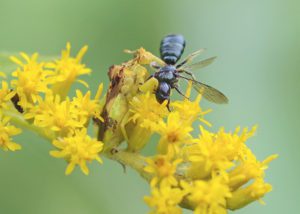
AMBUSH BUG AND PREY – A dynamite little predator and a BugLady favorite.
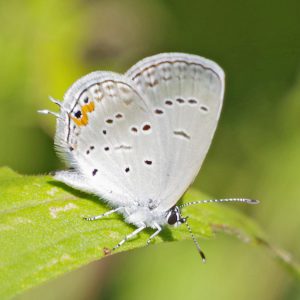
EASTERN TAILED-BLUE BUTTERFLIES have several generations per year, flying from May through September. The BugLady sees them along mowed trails until the first frosts, skittering just above the grass, looking for white clover to lay their eggs on (so set your mowers above the height of those clover flowers). The eggs soon hatch, and the larvae overwinter in the clover’s seed pods.
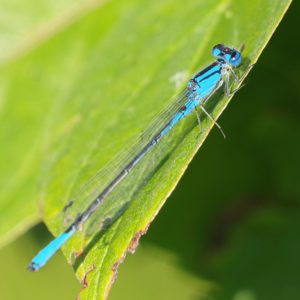
AZURE BLUET DAMSELFLY – Spilling over into late September, Familiar Bluets are the final bluets of the season, but the lushly-blue Azure Bluets are second-last. What a treat!
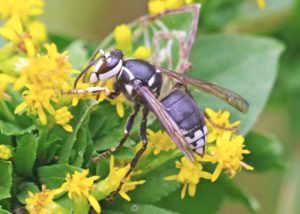
BALD-FACED AERIAL YELLOWJACKETS aka BALD-FACED HORNETS – It’s always exciting, as the leaves start to fall, to see how close we’ve been walking to the hidden nests of Bald-faced hornets https://bugguide.net/node/view/1632691/bgimage. Apparently, when the BugLady wasn’t paying attention, Bald-faced hornets were renamed to more accurately reflect their taxonomy, and now they’re called Bald-faced Aerial Yellowjackets (as opposed to the regular yellowjackets in the genus Vespula). People ask the BugLady if there are any insects that she’s afraid of. She’s not thrilled by ants (due to a misspent youth, during which she discovered that lederhosen offer no protection from an anthill), but these hornets/aerial yellowjackets do give her pause, because if you stumble into a nest, they can advance faster than you can retreat https://bugguide.net/node/view/1577524.
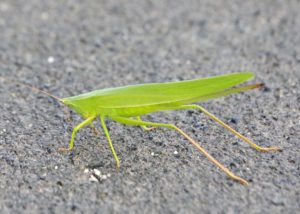
Why did the SWORD-BEARING CONE-HEADED KATYDID cross the road?
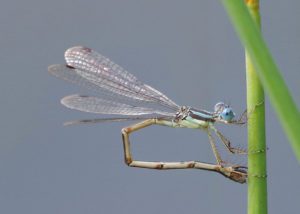
The egg that this SLENDER SPREADWING DAMSELFLY is inserting into the bulrush will spend the winter there in diapause (suspended animation). In spring, it will hatch, and in the form of a “pronymph,” exit the stem and drop into the water to complete its development as a nymph/naiad over the next few months.
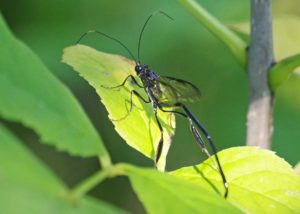
AMERICAN PELECINID WASPS are about 2 ½” long, and it’s mostly abdomen. She’s harmless unless you’re a June beetle grub, living happily out of sight underground looking for potatoes, in which case she will thread that long abdomen into the soil and deposit an egg on your exterior. She produces that egg via parthenogenesis. What a fascinating insect! https://uwm.edu/field-station/american-pelecinid-wasp/
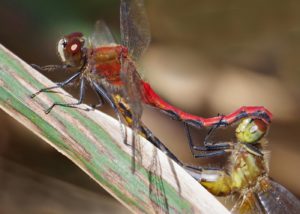
WHITE-FACED MEADOWHAWK DRAGONFLY – There are about a half-dozen species of meadowhawks in the BugLady’s neck of the woods – males are red; females and young males are generally amber; and they can be tricky to tell apart. One of the things that distinguishes meadowhawks is their sheer abundance – by mid-July, they start to outnumber the rest of the dragonflies. The BugLady did a dragonfly survey a few years ago in which she stopped counting meadowhawks at 150 and just checked “abundant.” Not this year. Not on the trails she walks.
Meadowhawks have a risky reproductive strategy. Rather than deposit eggs in water or aquatic vegetation, meadowhawks, especially White-faced Meadowhawks, gamble. Flying in tandem near, but not over, the edge of the pond, the female lobs eggs down onto ground that she hopes will be inundated by fall rains or spring floods. But parts of Southeastern Wisconsin had a dry fall followed by a dry spring, and the water levels never rose, and the BugLady thinks that lots of eggs got stranded. She doesn’t think she’s seen even 30 meadowhawks since the beginning of July.
What will happen? Maybe a wet fall will encourage the eggs of this year’s meadowhawks, but it might take a few years for the population to build back in from the edges.
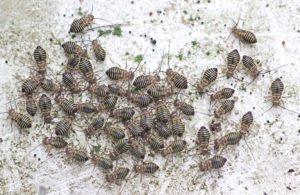
A small herd of BARK LICE appeared on the BugLady’s porch rail in mid-August. Bark lice, aka tree cattle, graze harmlessly on fungus, algae, and other little stuff on tree trunks (and porch rails). Better than bleach.
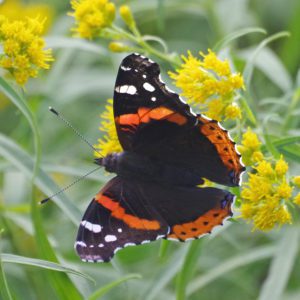
RED ADMIRAL BUTTERFLIES (historically called Red Admirables) are everywhere – in temperate parts of North Africa, Europe, Asia, New Zealand, North and Central America, and the Caribbean. They can get away with it because the caterpillar food plants are nettles, which are also everywhere. Like Monarchs, they’re migratory. They arrive from the South in May and produce a summer brood here. The new crop of Red Admirals heads south when the flowers fade, to overwinter there, and their offspring repopulate God’s Country again in the spring. Their populations are (inexplicably) cyclical; a few years ago we had a monster year for Red Admirals, but the BugLady saw very few this summer.
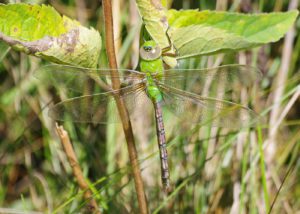
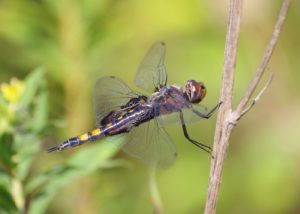
COMMON GREEN DARNERS also migrate (but it’s a little more complicated than that – Wisconsin has both a migratory and a non-migratory population of Common Green Darners). At 3” long, these are big dragonflies. BugLady was surrounded by them as she stood on the hawk tower near the shore of Lake Michigan in early September – she was looking for raptors, but it was all darners and BLACK SADDLEBAGS, as far out as she could scan with her binoculars.
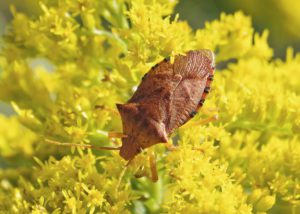
The SPINED SOLDIER BUG is a stink bug in the genus Podisus. Though many stink bugs are plant feeders and some are crop pests, this soldier bug is cruising the flower tops looking for caterpillars and other juicy items.
Autumnal equinox!
Kate Redmond, The BugLady
Bug of the Week archives:
http://uwm.edu/field-station/category/bug-of-the-week/
